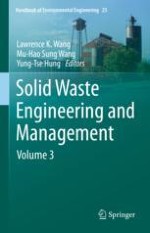2022 | OriginalPaper | Buchkapitel
8. Landfill Leachate Treatment
verfasst von : Hamidi Abdul Aziz, Mohamed Shahrir Mohamed Zahari, Zaber Ahmed, Shahrul Ismail, Izan Jaafar, Mohd Suffian Yusoff, Lawrence K. Wang, Mu-Hao Sung Wang
Erschienen in: Solid Waste Engineering and Management
Aktivieren Sie unsere intelligente Suche, um passende Fachinhalte oder Patente zu finden.
Wählen Sie Textabschnitte aus um mit Künstlicher Intelligenz passenden Patente zu finden. powered by
Markieren Sie Textabschnitte, um KI-gestützt weitere passende Inhalte zu finden. powered by
